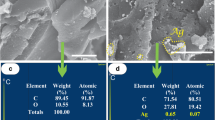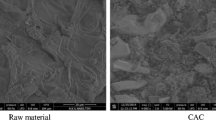Abstract
Human hair was used as raw material to produce activated carbon. Several physicochemical analyses such as Fourier-transform infrared spectroscopy, X-ray diffraction, pH zero point charge were performed to characterize the adsorbent. Moisture content in activated carbon, carbon tetrachloride number, benzene number, methyl blue adsorption test and iodine number were carried to analyze the qualities and performances of activated carbon. The results show the effectiveness of activated carbon in adsorption of the textile dyes with an elimination of 98.50% for adsorption of acid green 4G and 73.22% for adsorption of anthraquinone orange in 60 min of contact under constant stirring. The effect of both initial pH and agitation speed show that the optimal conditions were used to be medium shaking and slightly acidic to neutral for acid green 4G/activated carbon couple and medium shaking and basic pH for anthraquinone orange/activated carbon couple.










Similar content being viewed by others
References
Kant R (2012) Textile dying industry an environmental hazard. Nat Sci 4:22–26
Dahri MK, Kooh MRR, Lim LBL (2016) Adsorption of toxic methyl violet 2B dye from aqueous solution using Artocapus heterophyllus (Jackfruit) seed as an adsorbent. Am Chem J 15(2):1–12
Rawat D, Mishra V, Sharma RS (2016) Detoxification of azo dyes in the context of environmental processes. Chemosphere 15:591–605
Balapure K, Bhatt N, Madamwar D (2015) Mineralization of reactive azo dyes present in similated textile waste water using down flow microaerophilic fixed film bioreactor. Biores Technol 175:1–7
Benomara A, Guenfoud F, Mokhtari M (2019) Removal of methyl violet 2B by FePO4 as photocatalyst. Reac Kinet Mech Cat 127:1087–1099
Boudghene SH, Guenfoud F, Benomara A, Mokhtari M, Sonmez CM (2021) Synthesis of FeWO4 heterogeneous composite by the sol-gel process: enhanced photocatalytic activityon malachite green. Reac Kinet Mech Cat 133(6):563–578
Ge Q, Wang P, Wan C, Chung TS (2021) Polyelectrolyte promoted forward osmosis-membrane distillation (FO-MD) hybrid processor dye wastewater treatment. Environ Sci Technol 46:636–643
Zhu MX, Lee L, Wang HH, Wang Z (2007) Removal of an anionic dye by adsorption/precipitation processes using alkaline white mud. J Hazard Mater 149(3):735–741
Cai C, Zhang H, Zhong X, Hou L (2014) Electrochemical enhanced heterogeneous activation of peroxydisulfate by Fe-Co/SBA-15 catalyst for the degradation of OrangeII in water. Water Res 66:473–485
Benguella B, Nour AY (2009) Elimination des colorants acides en solution aqueuse par la bentonite et le kaolin. C R Chimie 12:762–771
Salima A, Benaouda B, Noureddine B, Duclaux L (2013) Application of Ultra lactuca and Systoceirastricta algea-based activated carbons to hazardous cationic dyes removal from industrial effluents. Water Res 47:3375–3388
Kusmierek K (2016) The removal of chlorophenols from aqueous from aqueous solution using activated carbon adsorption integrated with H2O2 oxidation. Reac Kinet Mech Cat 119:19–34
Dotto L, Santos JMN, Rodrigues IL, Rosa R, Pavan FA, Lima EC (2015) Adsorption of methylene blue by ultrasonic surface modified chitin. J Colloid Interface Sci 446:133–140
Souza TNV, Carvalho SML, Vieira MGA, Silva MGC, Brasil DSB (2018) Adsorption of basic dyes onto activated carbon: experimental and theoretical investigation of chemical reactivity of basic dyes using DFT-Based descriptors. Appl Surf Sci. https://doi.org/10.1016/j.apsusc.2018.04.087
Lansari I, Benguella B, Kruchinina N, Nistratov A (2020) Adsorption of a textile dye from aqueous solution on natural and modified sawdust. J Desalin Water Treat. https://doi.org/10.5004/dwt.2020.25861
Bini K, Gedefaw D, Pan C, Bjuggren JB, Sharma A, Wang E, Andersson MR (2019) Orange to green switching anthraquinone-based electrochromic material. Appl Polym Sci J. https://doi.org/10.1002/APP.47729
Chen W, Liu X, He RL, Lin T, Zeng QF, Wang XG (2013) Activated carbon powders from wool fibers. Powder Technol 234:7–83
Kifuani KMA, Noki VP, Ndelo JDP, Mukana WMD, Ekoko GB, Ilinga BL, Mukinayi JM (2013) Activated carbon powders from wool fibers. J Powder Technol 234:76–83
Liu J, Li WY, Liu Y, Zeng Q, Hong S (2014) Titanium(IV) hydrate based on chitosan template for defluoridation from aqueous solution. Appl Surf 293:46–54
Fernández A, Lassaletta G, Jiménez VM, Justo A, González-Elipe AR, Herrmann JM, Tahiri H, Ait-Ichou Y (1995) Preparation and characterization of TiO2 photocatalysts supported on various rigid supports (glass, quartz and stainless steel). Comparative studies of photocatalytic activity in water purification. Appl Catal B 7(1):49–63
Tizaoui K, Benguella B, Makhoukhi B (2019) Selective adsorption of heavy metals (Co2+, Ni2+ and Cr3+) from aqueous solution onto natural marne clay. Desalin Water Treat 142:252–259
Bertoni FA, Medeot AC, Gonzalez JC, Sala LF, Bellu SE (2015) Application of green seaweed biomass for Mo VI sorption from contaminated waters, kinetic, thermodynamic and continuous sorption studies. J Colloid Interface Sci 446:122
Li Z, Chang X, Zou X, Zhu X, Nie R, Hu Z, Li R (2009) Chemically-modified activated carbon with ethylenediamine for selective solid-phase extraction and preconcentration of metal ions. Anal Chim Acta 632:272–277
He Q, Chang X, Zheng H, Jiang N, Hu Z, Wang X (2009) Determination of chromium(III) and total chromium in natural waters using a surface ion imprinted silica gel as selective adsorbent. Int J Environ Anal Chem 88:373–384
El-Nabarawy T, Petro NS, Abdel-Aziz S (1999) Adsorption. Sci Technol 15:47
Juan Y, K-Qiang Q (2006) Preparation of activated carbon by chemical activation under vacuum. J Environ Sci Technol 43:3385–3390
Boehm HP (2002) Surface oxides on carbon and their analysis: a critical assessment. Carbon 40:145–149
Solomon PH, Wang XM (1984) Infrared adsorption spectroscopy. Publishing House Sci Beijing 27:15–18
Yang T, Lua AC (1984) Textural and chemical properties of zinc chloride activated carbons prepared from pistachio-nut shells. Mater Chem Phys 100:438–444
Bouchelta C, Medjram MS, Bertrand O, Bellat J (2008) Preparation and characterization of activated carbon from date stones by physical activation with steam. J Anal Appl Pyrol 82(1):70–77
Xie Z, Guan W, Ji F, Song Z, Zhao Y (2014) Production of biologically activated carbon from orange peel and landfill leachate subsequent treatment technology. J Chem. https://doi.org/10.1155/2014/491912
Lente G (2015) Deterministic kinetics in chemistry and systems biology: the dynamics of complex reaction networks. Springer briefs in molecular science. Springer, Cham
Peyman G, Alireza K, Reza DCS, Amit B (2019) A review on carbon-based materials for heterogeneous sonocatalysis: fundamentals, properties and applications. Ultrason Sonochem 58:104681
Wang L, Zhang J, Zhao R, Li C, Li Y, Zhang C (2010) Adsorption of basic dyes on activated carbon prepared from polygonum orientale Linn: equilibrium, kinetic and thermodynamic studies. Desalination 254:68–74
Kusmierek K, Swiatkowski A (2015) The influence of different agitation techniques on the adsorption kinetics of 4-chlorophenol on granular activated carbon. Reac Kinet Mech Cat 116:261–271
Author information
Authors and Affiliations
Corresponding author
Additional information
Publisher's Note
Springer Nature remains neutral with regard to jurisdictional claims in published maps and institutional affiliations.
Rights and permissions
About this article
Cite this article
Lansari, I., Benguella, B., Kruchinina, N. et al. The removal of acid green 4G and anthraquinone orange from aqueous solution using adsorption on activated carbon from human hair. Reac Kinet Mech Cat 135, 987–998 (2022). https://doi.org/10.1007/s11144-022-02181-2
Received:
Accepted:
Published:
Issue Date:
DOI: https://doi.org/10.1007/s11144-022-02181-2




